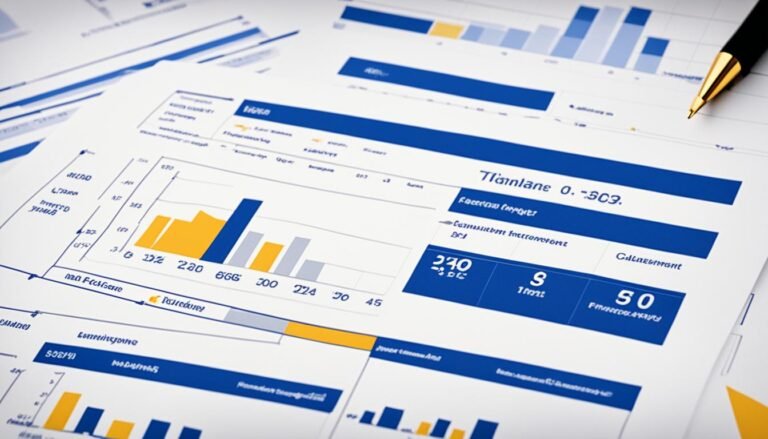Review of Professional Risk Manager (PRM) Qualification
Did you know the 2008 global financial crisis led to over $3 trillion in losses?* This shows how crucial good risk management is in finance. The PRM qualification we’re looking at now is a tough certification. It teaches professionals to spot, measure, and lessen financial risks.
Key Takeaways:
- The PRM certification is designed to equip professionals with the knowledge and skills needed to manage financial risks effectively.
- Candidates must meet certain eligibility criteria, including a graduate school degree, relevant work experience, or a bachelor’s degree with work experience in the financial services industry or risk management.
- The PRM certification process consists of completing the PRM Designation program and passing two exams that cover various aspects of risk management and finance theory.
- PRM certification offers numerous benefits, including enhanced career prospects, industry recognition, and a competitive advantage in the field.
- Maintaining the PRM designation requires a Sustaining PRMIA Membership and completing continuing risk learning credits annually.
Next, we’re diving into the PRM’s requirements, how you get certified, its perks, and how to keep it up. This info will help you decide if the PRM is a certification you want to go for.
*Source: International Monetary Fund (IMF)
Eligibility for PRM Certification
To get a PRM certification, applicants need to meet some rules from the PRMIA. This certification shows you have what it takes to understand and handle financial risks. It’s highly respected in the field of risk management.
To be able to apply, you must:
- Graduate School Degree: Have a grad school degree in a related area.
- Chartered Financial Analyst (CFA): If you’re a CFA, you’re good to go.
- Bachelor’s Degree with Work Experience: With a bachelor’s, you need two years of relevant work.
- Work Experience: Already have four years full-time experience in finance or risk.
Besides these, you must be a PRMIA member to apply. Membership means you get extra resources, meet other professionals, and join in on learning activities. It’s a good way to grow in your career as a risk manager.
After meeting all criteria, you can start the PRM Designation program. This course covers risk management and finance topics. It gets you ready for the tough PRM exams. These tests check if you really understand risk management.
Being eligible for the PRM certification is a big deal. It opens the door to becoming a certified Risk Manager. This is a chance to get ahead in the world of risk management.
PRM Certification Process
The PRM certification process has steps to guide applicants. Knowing these steps is key for those aiming for the Professional Risk Manager (PRM) title.
Enrollment and Examination Period
Candidates have 36 months from enrollment to finish the PRM program and take the exams. This period lets candidates move at their own pace. Using time wisely is vital to be well-prepared for the exams.
Updated Examinations
The PRM exams are now updated to match the newest industry trends and practices. The program features two new exams: Exam 1 and Exam 2. These tests check what you know about risk management and finance theories.
Exams now focus intensely on risk management and finance. They inspect your knowledge of finance theory, different markets, and how to measure risk. They also test your grasp of risk frameworks, managing assets and liabilities, and certain risk fields. Know that both exams have multiple-choice questions.
PRM Certification Fees
Applying for the PRM status comes with various costs like application and program fees. Plus, there are charges for retaking exams. When planning to get the PRM certification, it’s crucial to keep these costs in mind.
Note: Detailed fee structure and payment methods can be found on the official PRMIA website.
Understanding the PRM certification process helps future risk managers start their journey. This worldwide recognized title boosts job prospects. It also proves your expertise in risk management.
Benefits of PRM Certification
The PRM (Professional Risk Manager) certification is very valuable for those in risk management. It’s known worldwide as a mark of someone skilled in risk management. It shows they know the tools, techniques, theories, and principles well.
Having a PRM title means you earn a lot of respect in your field. Employers value your expertise. This can help you get promoted faster and find better jobs.
With a PRM certification, you stand out in the job market. You’re more likely to be chosen for risk management jobs. It’s also good for finance experts, CEOs, and decision-makers needing strong risk awareness.
The PRM shows you deeply understand risk management. You can prove your ability to find, assess, and deal with risks effectively. It means a lot in the eyes of potential employers.
PRM professionals work in big banks, companies, universities, governments, and more. The certification opens doors to a variety of jobs. It helps you discover new industries and challenges.
Industries Employing PRM Designees
| Industry | Examples of Organizations |
|---|---|
| Banking | JPMorgan Chase, Citibank, HSBC |
| Insurance | Prudential, AIG, Allianz |
| Consulting | McKinsey & Company, Deloitte, KPMG |
| Investment | BlackRock, Vanguard, Goldman Sachs |
| Government | Central Banks, Regulatory Agencies |
| Non-Financial Organizations | Universities, NGOs, Manufacturing Companies |
This certification also helps with continuous learning in risk management. It equips you with the latest tools and knowledge. You’ll be prepared for changes and new trends.
Getting a PRM certification shows you’re dedicated to being the best in risk management. It can boost your career. You might see better salary offers and perks.
In conclusion, PRM certification is great for those in risk management. It proves your expertise and opens many doors. It keeps you learning and growing as a professional. And it lays a solid groundwork in risk management basics.
Maintenance of PRM Designation
To keep their PRM titles, people must pay a yearly fee for their PRMIA membership. They also need to earn 20 CRL credits each year.
PRMs can earn CRL credits in many ways. They can go to industry events, take part in webinars, finish courses, or do research and write.
By getting these credits, PRMs learn new things and show they are dedicated to growing in their field.
Example of CRL Credit Activities
Let’s see how PRMs can get CRL credits with different activities:
| Activity | CRL Credits Earned |
|---|---|
| Attending a risk management conference | 5 credits |
| Completing an online risk management course | 3 credits |
| Participating in a risk management webinar | 2 credits |
| Presenting a risk management research paper | 4 credits |
| Writing a risk management article for publication | 2 credits |
The table shows how many CRL credits each activity gets you. PRMs can mix different activities to meet their goals and stay interested.
Comparison with Other Risk Management Certifications
Looking into a career in risk management means checking out different certifications. Besides the PRM, there’s the CRM, FRM, and CRMP. They all give professionals specific knowledge in risk management.
CRM Certification
The CRM certification is from the National Alliance. It focuses on how to put risk management into action. It teaches skills to find, understand, and handle risks in many fields.
FRM Certification
The FRM, from the Global Association, dives deep into financial risks. It’s for those in finance, covering risk in investments and markets. The certification is known for its detailed approach to financial risk management.
CRMP Certification
CRMP, offered by DRI International, is for specialized risk managers. It highlights planning for crises and keeping business operations going. This certification helps deal with tough situations and avoid risks.
Choosing the Right Risk Management Certification
Choosing the right certification depends on your goals and where you want to work. The PRM is broad, perfect for understanding risk principles and analyzing financial risks.
The CRM is great for risk work in all fields. For those in finance looking to manage financial risks better, the FRM is ideal. And the CRMP is for experts in risk management, focusing on crisis and planning.
Think about what you’re good at and where you want to go. Each certification brings different skills and focuses. Choose one that matches your strengths and the path you want to take.
| Certification | Offered By | Focus Area |
|---|---|---|
| PRM | Professional Risk Managers’ International Association (PRMIA) | Comprehensive risk management and financial risk analysis |
| CRM | National Alliance for Insurance Education and Research | Risk management implementation and analysis |
| FRM | Global Association of Risk Professionals | Financial risk management |
| CRMP | DRI International | Specialized risk management, crisis management, and business continuity planning |
Testimonials from PRM Designees
PRM designees have told us how the PRM certification changed their careers for the better. They say they can use what they’ve learned in the real world. They also mention the importance of the materials they studied. Lastly, they talk about how the certification improved their risk management skills.
“The PRM certification has really boosted my career. I now fully understand risk management thanks to the program’s lessons. This knowledge lets me handle financial risks wisely, helping my company make better choices.”
– Alice Thompson, PRM Designee
Those who have their PRM say it helped them find new jobs and grow professionally. They believe they are better than others in handling risk, which makes them important to bosses and clients. So, they stand out in the job market.
Gaining the PRM has done even more than just helping their careers. It’s made them more sure of how good they are at risk management. This lets them solve hard problems better and make choices that help their businesses win.
PRM Success Stories
Here are a few success stories shared by PRM designees:
-
“Getting the PRM certification truly changed my career. My skills got better and I know more about dealing with risk in all kinds of businesses. Now, I work in fintech, using what I learned to help manage our money better.”
– Mark Rodriguez, PRM Designee -
“The PRM certification made me really understand how to do risk management right. The study’s real-life examples helped me a lot at work. Having the PRM has made me grow a lot as a professional.”
– Emily Chen, PRM Designee
PRMIA Impact
The Professional Risk Managers’ International Association (PRMIA) is very important to PRM designees. It helps them meet people, share what they know, and keep growing in their job.
Being part of PRMIA means having friends all over the world in risk management. It also means getting information, going to talks, and joining important meetings. Plus, it adds to how well they are seen in their career.
| PRMIA Impact | Benefits |
|---|---|
| Networking Opportunities | Connect with risk management professionals globally. |
| Industry Resources | Access to valuable risk management resources and research. |
| Professional Development | Continuing education and thought leadership events. |
| Enhanced Credibility | Recognized association supporting the PRM designation. |
PRM certification and PRMIA make a big difference in the lives of risk managers. By joining, PRM designees get better, meet leaders, and help their groups a lot.
Overview of Risk Management and Financial Risk Management
Risk management is key in many industries. It’s about finding, checking, and ranking risks to thrive. Companies use strategies to lower or handle these dangers wisely. There are many risk types like operational, credit, market, and reputational risks. By dealing with these early, businesses protect their money and name.
Financial risk management deals with dangers in the money world. It involves using tools and plans to face risks from market shifts, interest rates, and more. Experts look at data and models to find risks, measure them, and deal with them smartly.
Risk management matters a lot in many fields like banking and insurance. Good risk management in banks helps keep them strong and law-abiding. Insurers use it to understand and control damage from claims. Consultants offer advice to lower risks, guiding their clients. Investment houses protect their client’s investments by managing risks well.
Benefits of Risk Management
Putting strong risk plans in place helps a lot.
- This lets companies spot and deal with dangers ahead of time.
- It guards against big money losses and keeps businesses running.
- It makes work smoother by cutting out guesswork and using resources better.
- Companies see and handle risks more as a team.
- It makes others trust them more, like investors and the law, showing they mind their risks well.
In today’s changing world, good risk management is a must for growth and survival. By making risk plans part of the way they do business, companies can stay strong, flexible, and ahead of the competition.
Overview of the Professional Risk Managers’ International Association (PRMIA)
The Professional Risk Managers’ International Association, or PRMIA, started in 2002. It helps people working in risk management worldwide. They provide resources, networking, and educational programs.
A board of directors, elected from the members, manages PRMIA. This means its decisions are thoughtful and keep members’ needs in mind. PRMIA has chapters globally, where risk professionals can meet and work together.
If you’re aiming for a PRM certification, becoming a PRMIA member is key. Members get benefits like lower fees for certifications, access to the latest research, and the chance to join events and conferences. This is all to help members grow in their careers.
For professional growth, PRMIA offers many resources. They have online forums, webinars, and workshops for sharing ideas. Also, members can use a big library of articles and studies on risk management.
PRMIA Overview At-A-Glance:
- Founded in 2002 as a non-profit organization
- Global community for risk management professionals
- Board of directors elected by PRMIA membership
- Chapters in major cities worldwide
- Offers resources, networking opportunities, and educational programs
- Membership essential for PRM certification
“PRMIA is a great place for risk managers. Its resources and connections have really helped my career in risk management.” – John Smith, PRMIA Member
Conclusion
The PRM certification is top-notch for risk management pros. It gives a deep understanding of risk identification, evaluation, and reduction. This knowledge helps in various industries. Achieving this certification boosts job chances and allows for new paths to open.
Getting the PRM qualification shows skill in handling financial risks and cutting them down. It improves career growth and makes a person more competitive. Those in risk management should look into PRM. It’s a strong step forward.
Final thoughts on PRM qualification
The PRM certification dives into risk management inside and out. It’s key for those aiming for a career in this field. With this certification, one stands out for their dedication and effective financial risk handling.
Overall, PRM equips individuals with needed risk management skills. It boosts job opportunities and profession growth. In a changing risk scene, PRM keeps its value. It’s a key badge for those wanting to lead in risk management.
FAQ
What is the eligibility criteria for the PRM certification?
To be eligible for PRM, you need a graduate degree. Or you can have a CFA. You can also have a bachelor’s and two years of experience. Four years of experience in finance or risk management works too. You must also be a PRMIA member.
What is the process for obtaining the PRM certification?
First, join the PRM program. You have 36 months to finish it. The program includes two exams. These cover topics like finance theory and risk management. You must show your knowledge in these areas.
What are the fees associated with the PRM certification?
The PRM certification costs an application and program fees. There are extra exam retake charges if needed.
What are the benefits of obtaining the PRM certification?
Getting the PRM shows you know your risk management. It can bring new job chances and help you stand out.
How can I maintain my PRM designation?
Keep your PRM title by having an active PRMIA membership. Also, earn 20 CRL credits each year.
How does the PRM certification compare to other risk management certifications?
The PRM is all about financial risk. Other certifications like CRM, FRM, and CRMP have different focuses and needs.
Can you provide any testimonials from PRM designees?
PRM certificate holders have shared how it helped their careers. They say it opens new doors and shows their skills in risk management.
What is the definition of risk management?
Risk management is about spotting, checking, and ranking risks. It’s about putting plans in place to handle these risks. This includes risks in operational, credit, market, and reputation areas.
What is the Professional Risk Managers’ International Association (PRMIA)?
The PRMIA gives risk management pros tools, chances to connect, and learn. You need to be a member to get the PRM certification.
What is the conclusion of this PRM certification review?
The PRM certification is key for those in the risk management field. It gives a deep understanding and skills in financial risk management. It comes with many pluses like moving up in your career and gaining respect in your profession.








